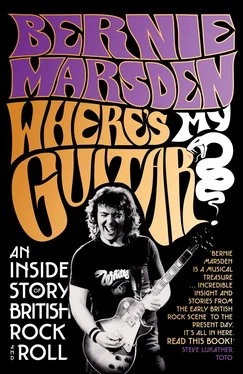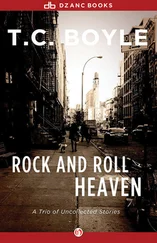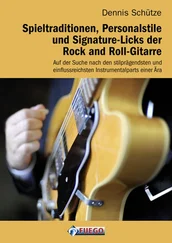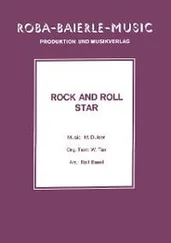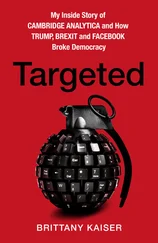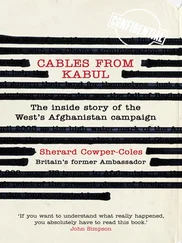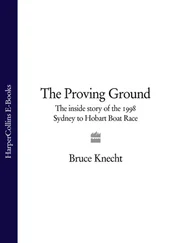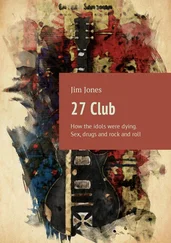‘Now listen and learn,’ she said. She played the first notes on the piano. I recognised the tune, the theme from Z Cars on TV. The girls in my class looked on. I picked up the guitar and played the Z Cars melody almost instantly, Mrs Clark was looking a little vexed. I then played the guitar intro to Chuck Berry’s ‘Johnny B. Goode’.
‘So, can you play that?’ I asked her. There were more than a few giggles. Mrs Clark was furious and, to contain her embarrassment, she left the room. I laughed, but she should have taken pleasure in seeing one of her own students playing this way, as an untrained natural. I am still irritated by the way that people with obvious talents were disregarded. If I had listened to my teachers I would never have left Buckingham, and never have tried to make it as a guitarist. It makes me wonder how many potential writers, musicians and artists there were in those dingy, soulless schoolrooms during the Sixties who were ridiculed for having such dreams.
I needed a practical music education. Enter my cousin John Keeley, three years older than me, who visited from Liverpool. He sang and played harmonica in a band, which impressed me a lot. I told him that I could play the guitar, which didn’t impress him, but he did listen to me playing along with recordings by Gerry and the Pacemakers and the Searchers, before instructing me to throw the records away. He told me to get LPs by Howling Wolf, Sonny Boy Williamson, Muddy Waters and Buddy Guy – but I did refuse to give up the Beatles. John had seen Williamson at the Cavern with the Yardbirds, and allowed me to keep my live Yardbirds LP featuring the young Eric Clapton. The blues hit me like a hurricane.
I became obsessed with all things Eric Clapton. I even bought Tuf town shoes because I read he wore them – I read any Clapton magazine article and I paid close attention to his influences. I soaked them all up – I was a musical sponge. If Clapton mentioned a player in an interview, I went straight down to the local shop to order that record. Some were so obscure, some on American labels with strange names: Chess, Federal, Sue and Pye International with the red-and-yellow labels. Artists such as Freddy King, Otis Rush, T. Bone Walker, and more. I slowed down the records to 16 rpm on the radiogram, making it a little easier to learn the guitar parts.
It wasn’t always straightforward to find this music. A folk guitarist first suggested I should listen to BB King. The folk player had a really good fingerstyle and liked the way I played, saying it was a very different approach. I was lucky to get a UK Ember label 45-record by mail order of ‘Rock Me Baby’, BB King’s great song. When that Ember record arrived, that was really it. I later found King’s UK Stateside releases, the European versions of the early BluesWay/ABC. Live at the Regal is the one liked by most guitarists, but for me it was Blues is King . Both were recorded in Chicago in the mid-1960s with a small band, and BB is on great form vocally and his guitar playing still motivates and inspires me.
If asked today, I might most often say that the music of The Beatles was the source of my musical career. But, if I am really honest, the blues music went on to inspire and motivate me most of my life. I had already been aware of Big Bill Broonzy, his name fascinated me, but I never really knew what blues music was. But, once I had heard the Yardbirds and John Mayall I was looking for their source material. I searched for BB King, Leadbelly, Big Bill, Brownie McGhee and Sonny Terry, which led me to Freddy and Albert King. I was given a Louisiana Red album when I was about 14 called Low Down Back Porch Blues . I liked it a lot, although I didn’t really understand what it was about.
At around that same age, I saw Lightnin’ Hopkins, Sister Rosetta Tharpe and Muddy Waters on TV. I was mesmerised. There is some quite phenomenal footage from 1964 of Rosetta Tharpe tearing it up with a white Gibson SG Custom at a railway station platform in Cheshire. It sounds crazy but it is a fact. Try and find it! This was the music I wanted to play. I bought a 45 of Howlin’ Wolf, ‘Smokestack Lightning’, which featured a fantastic guitar player on B-side ‘Goin’ Down Slow’– this was Hubert Sumlin. Hubert played with both of the great Chicago blues players, Muddy Waters and Howlin’ Wolf.
I was soaking up all this music. Gone were all my records of UK artists, even The Beatles and The Hollies were at the back of the pack when it came to the bluesmen. ‘Boogie Chillen’ by Hooker fascinated me, and still does. The guitar part is so weird, but I loved it and tried to play it. I didn’t know about capos or tunings then, but I loved the sound. I found that I could reproduce some of Sonny Boy’s harmonica parts on the guitar. That inspired me a lot. Just a tiny fraction of this music was developing my own style and, even though I was fully aware that Eric Clapton and Peter Green had already got it down, I did persevere.
When Cream themselves played Aylesbury in February 1967 there was nothing that would stop me seeing them. My pal Alan Clarke and I hitchhiked to a venue which was heaving with the largest number of people I had ever seen in one space. And then Cream were there: Jack Bruce, Ginger Baker, and ‘God’ himself, Clapton. Their Marshall amps towered on the small stage, Eric playing his Gibson SG Standard and I heard the ‘woman tone’ in person. I watched in a kind of dream state as they opened with ‘N. S. U.’, and played ‘Sleepy Time Time’, ‘Sweet Wine’, ‘Born Under a Bad Sign’, ‘Cat’s Squirrel’, and a devastating ‘I’m So Glad’. They were magnificent.
I was jolted into the real world in a surprising way. I felt a sharp prod in my back, and turned around to see Elizabeth Rees, the new French teacher. She was in a very good mood, looking really good, and had a definite twinkle in her eye. She straight away said she would take us back to Buckingham after the show. She was with a friend, a nasty little piece of work named Drew, who taught history. How pissed off Drew must have been to take us back on his date. Alan and I were just grateful not to walk back the sixteen miles.
Outside Buckingham town hall I thanked Drew for the lift, he eyed me with some contempt, and I got out of the car. To my surprise – and Drew’s shock – Elizabeth also said ‘Thanks’ and ‘Goodnight’ to him. Man, he must have been livid. Alan walked back home while Liz invited me back for a coffee at her flat in Well Street, a minute’s walk away.
I was still filled with the excitement of the Cream gig, until it slowly dawned on me that I was alone with my French teacher in her flat. She was calm and chatty, and we discussed the show and our musical interests: all very grown-up stuff. Liz had liked that I played ‘Hoochie Coochie Man’ at the pub. She went to her bedroom and came back with an album to play on her Dansette record player. It was The Freewheelin’ Bob Dylan . I had never bothered with acoustic music, unless played by black musicians. The only folk music I was aware of was by the likes of Wally Whyton and the King Brothers on the radio show Family Favourites . Bob Dylan was so radical. I was quite stunned.
‘Listen to his words,’ she said. I still listen to them today.
She told me I could be like my heroes and that if I practised, worked hard and, above all, dedicated myself to being a musician I could make it a career. She pointed that neither Bob Dylan nor Eric Clapton had ever seen the inside of a university, and that the old USA blues players that I worshipped were lucky to get any schooling at all. I really listened to her. Academically, I was way behind, but in learning about life I was taking a huge step forward.
I spent a lot of time at school with Liz Rees, and rumours were rampant, particularly as my French was not improving. Liz was a bohemian free spirit, just the person a young lad of fifteen years of age should stay away from. I was infatuated, of course: she did exactly as she pleased and didn’t give a damn about authority.
Читать дальше
